All past history has been changed and the machines of the ancients are traumatized! This week IDW Publishing releases the second installment of their adaptation of Harlan Ellison’s original teleplay for The City on the Edge of Forever. Chronometric spoilers, a preview, and more after the break.
Star Trek: Harlan Ellison’s The City on the Edge of Forever, The Original Teleplay #2 of 5
Original teleplay by Harlan Ellison, adaptation by Scott Tipton and David Tipton, art by J.K. Woodward, letters by Neil Uyetake, edits by Chris Ryall
Story
 Following Beckwith’s headlong charge into the timestream, no one is hurt, but the Guardians inform Kirk that everything has changed and they must inspect the damage. The landing party transports back to the Enterprise to become captive aboard the Condor, a ship of renegades. The Starfleet crew overcome their captors and secure themselves in the transporter room. Kirk asks Yeoman Rand to hold the room while he and Spock return to the planet’s surface, intending to go after Beckwith.
Following Beckwith’s headlong charge into the timestream, no one is hurt, but the Guardians inform Kirk that everything has changed and they must inspect the damage. The landing party transports back to the Enterprise to become captive aboard the Condor, a ship of renegades. The Starfleet crew overcome their captors and secure themselves in the transporter room. Kirk asks Yeoman Rand to hold the room while he and Spock return to the planet’s surface, intending to go after Beckwith.
The Guardians are skeptical, but allow Kirk and Spock to enter the timestream at some unknown point before Beckwith entered. Their task is to look for the focal point, with only a few cryptic hints from the Guardians about what that might actually be.
Kirk and Spock materialize outside a twentieth century soup kitchen and are immediately marked as outsiders by an unfriendly mob. Spock is astonished at their animosity. Making a run for it, the time travelers escape down a dark alley, and into a basement.
Review
After setting the stage for a catastrophic change to the timeline in the first issue of this mini-series, Scott and David Tipton, continue their adaptation of Ellison’s teleplay with the consequences of that event. The comic script is sticking very closely to the television script and it feels like we’re watching a television episode with some rich, extended scenes. I’m enjoying the story, but I wish the the pacing of their adaptation would screen a little faster. I realize that’s the spoiled attitude of someone who consumes way to much genre television. Reading a comic should, and probably can give us the opportunity to examine the events taking place in a more thoughtful way. I’ll try to keep that in mind as the story continues.
The best line of dialogue in a Star Trek comic I’ve read in recent memory occurs when Kirk asks Rand if she can hold the transporter room from the renegade crew about to burn their way thru the doors. Her response? “I can, sir.” It’s a classic Trek moment superbly highlighted by J.K. Woodward’s portrait of a determined Yeoman Rand. He also gives us a good laugh a few pages later when Spock questions Kirk about the hostility of the soup kitchen mob. Woodward captures Spock’s Vulcan incredulity and concern with astonishingly arched eyebrows. In fact, Woodward is firing on all thrusters this issue, with a shipboard battle, an extended discussion with the Guardians, and the depression-era mob scene. This is some of his best Trek work. Will he be able to maintain this kind of momentum for three more issues? We’ll have to wait and see.

Calm down Spock!
The regular cover for The City on the Edge of Forever #2 is by Juan Ortiz. The subscription cover is drawn by Paul Shipper. Both covers for this issue feature Kirk and Spock. The regular cover features a posterized Captain and First Officer. The subscription cover features the big heads of the big two. This is where the difference between Ellison’s teleplay and the broadcast version really hit me. No big three. No McCoy. That realization leaves me with an unsatisfactory feeling about the cover art that probably isn’t deserved, but can’t be helped. As much as I’m enjoying this adaptation, I suppose I’m beginning to understand why the original script was altered before broadcast.


Cover: Art by Juan Ortiz, Subscription Cover: Art by Paul Shipper
The City on the Edge of Forever #2 will be at your local comic shop Wednesday, July 23 and at IDW Digital. There will also be a Madefire Motion Book available as an in-app purchase with the Madefire Motion Books app. Madefire Motion Books can also be purchased online at deviantART if you are a member and have points. You can sample the Madefire Motion Book of The City on the Edge of Forever #1.
Preview of The City on the Edge of Forever #2
Memorandum
Back in February 2013, Mission Log Podcast posted their recap and review of The City on the Edge of Forever. In addition to the podcast, they posted a fascinating six-page memo from Bob Justman to Gene Roddenberry discussing Ellison’s Second Revised Final Draft. Read the memo at Mission Log Podcast Discovered Documents.
If you didn’t catch the podcast, you can listen at the Mission Log Podcast Archive or right here at TrekMovie.
Mission Log Podcast #28: The City on the Edge of Forever
Star Trek comics coming soon
Next up from IDW Publishing are Star Trek #36, City on the Edge of Forever #3, and Star Trek: New Visions #2: Time’s Echo You can pre-order Star Trek comics at a discount from Things From Another World, just click on the banner below.
Mark Martinez is an obsessive-compulsive Star Trek comics reader and collector. You can visit his website, the Star Trek Comics Checklist for more than you ever needed to know about Star Trek comics.

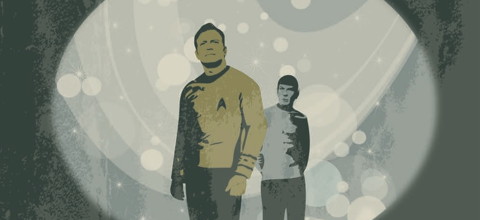






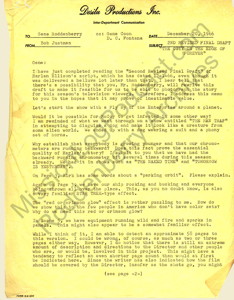
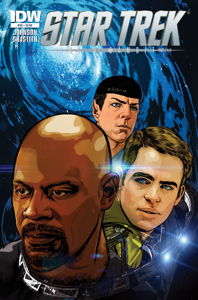
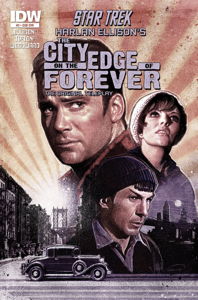
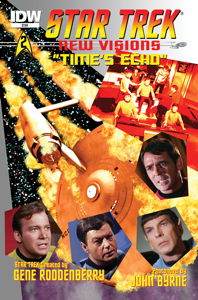

As is often the case, (for me) there is a lot to learn and enjoy from such contributions.
Thank you for posting!
thanks for the review,i enjoyed the first and like understand why it had to be changed on only for budget reason also story content that dose not fit into the star trek that had been set,still good to read it would be so cool if they did this with some of the other episodes
Justman’s memo is cold! I see a lot of brilliance in it, but I can’t imagine how painful it would be to have someone dissect my baby in front of me like that. And btw, “jerry rig” is correct, as is “jury rig” or something that is “jerry-rigged.” Parts of Bob’s letter seem like he’s loading on because he already deeply hates Harlan.
Having said that, I’d have loved to see Rand in a strong role. Sorry the team couldn’t have kept her on, with some but not too much sexual tension for Kirk, sort of a Moneypenny.
Ah well, we just have to settle for the classic we got…
Can I order these comics (non-digital versions) online?
found it… for some reason, they don’t make it easy.
Really enjoyed the first issue and will hit my comics shop this weekend to pick up #2. Such a fascinating experience to see the differences between the broadcast episode and the original teleplay. Must have been tough for the “guest” writers to get a feel for the characters and their distinct voices so early in the production…especially before the show even started to air.
Also a nice peek at what the show may have done with Yeoman Rand if Grace Lee Whitney hadn’t been let go.
I have to smile reading Bob Justman’s memo to Gene Roddenberry about Ellison’s second revised draft, because this memo sounds like some of us who ask the tough questions about STID’s inconsistencies.
Questions SHOULD be asked of the writer(s) but with “City on the Edge of Forever,” they were asked. In STID, they apparently were never asked.
7 – Paramount asked. The answer was always: M-O-N-E-Y.
They took the best bits from the money-makers and slammed ’em together. STID never earns its emotional bits. It just flies them in your face.
Anyone ever notice when Edith and Kirk are walking down the street it’s Mayberry in fact they pass Floyd’s barber shop.
#9. Jim – July 22, 2014
Yes, I have to confess to being so obsessive at one time to notice Floyd’s in the episode.
But I’m even more curious as to whether you are intimating that the comic duplicates this?
CmdrR, Justman’s memo is cold! I see a lot of brilliance in it, but I can’t imagine how painful it would be to have someone dissect my baby in front of me like that. And btw, “jerry rig” is correct, as is “jury rig” or something that is “jerry-rigged.” Parts of Bob’s letter seem like he’s loading on because he already deeply hates Harlan.
Well, Justman was the guy managing the money and overseeing some of the continuity. And he was memo’ing Roddenberry, not Harlan Ellison/”Cordwainer Smith” [I really like that name, it’s on a par with “Kilgore Trout”].
IDK if Bob hated Harlan at that point or not, but having gone thru several iterations of what looked like a damn good story, and having told Ellison of the limitations of TV broadcast, and furnished him a Writer’s Guide, and going thru yet more iterations must have been, at the least, irritating. A one-hour TV script is supposed to come in at around 25 pages, innit?
#11. Marja – July 22, 2014
Harlan had already scripted two highly-acclaimed outings of the one-hour anthology series, THE OUTER LIMITS, by then. He knew how to write for the time slotted. I also believe he had scripted some action/adventure and detective shows eps as well but I’ve never bother to dig them out before. Checking….
From Imdb.com:
The Man from U.N.C.L.E. (TV Series) (story – 1 episode, 1967) (teleplay – 1 episode, 1967) (writer – 1 episode, 1966)
– The Pieces of Fate Affair (1967) … (story) / (teleplay)
– The Sort of Do-It-Yourself Dreadful Affair (1966) … (writer)
1964 The Alfred Hitchcock Hour (TV Series) (story and teleplay – 1 episode)
– Memo from Purgatory (1964) … (story and teleplay)
1964 The Outer Limits (TV Series) (written by – 2 episodes)
– Demon with a Glass Hand (1964) … (written by)
– Soldier (1964) … (written by)
1964 Voyage to the Bottom of the Sea (TV Series) (written by – 1 episode)
– The Price of Doom (1964) … (written by – as Cord Wainer Bird)
1963-1964 Burke’s Law (TV Series) (written by – 4 episodes)
– Who Killed 1/2 of Glory Lee? (1964) … (written by)
– Who Killed Andy Zygmunt? (1964) … (written by)
– Who Killed Purity Mather? (1963) … (written by)
– Who Killed Alex Debbs? (1963) … (written by)
1963 Route 66 (TV Series) (based on a story by – 1 episode)
– A Gift for a Warrior (1963) … (based on a story by)
1963 Ripcord (TV Series) (written by – 1 episode)
– Where Do Elephants Go to Die? (1963) … (written by)
About the only thing I can imagine that might have caused his timing to be off is that I believe by 1966 the network had been shaving back the time available for drama and increasing that available for ads?
It’s television, folks. This is what happens. It’s a brilliant concept — but I still like the aired version better than what Ellison wrote. And he’s had 50 years of publicity from the stink he out on over this.
“I have to smile reading Bob Justman’s memo to Gene Roddenberry about Ellison’s second revised draft, because this memo sounds like some of us who ask the tough questions about STID’s inconsistencies.”
My guess is that if Bob Justman had been asked to provide feedback on Trek 2009 and STID, his memos would have run longer than both scripts combined.
It was said about him that he could weigh a script by hand and tell you to the penny how just much it would cost to shoot. I think it fair to say that he found Ellison personally exasperating to work with–they had memorably teamed up before on “The Outer Limits”–but was unstinting in his praise of the writer’s brilliance. After getting just about all of the changes on “City” that he’d asked for, Justman was honest enough to ruefully admit his regret that much of the poetry of Ellison’s original teleplay had been lost. Iconic as the aired version has become, he was right.
This issue of the comic may actually be the weakest, as it adapts the least impressive portion of Ellison’s script. That said, it’s likely to be the most worthwhile thing you’ll see with the name “Star Trek” on it for the foreseeable future.
(Oh, and Marja? Just FYI Ellison’s nom de Guerre was “Cordwainer Bird”. Cordwainer Smith was a real-life writer of science fiction pulps.)
#13. Jack – July 22, 2014
He didn’t just get publicity. Because the producers, studio, etc. really didn’t know what they were doing in all of these machinations, Ellison was able to file and keep the original copyright which allow him to continue to profit from it over the years — something the industry is usually very sharp about screwing original creators out of.
“Ellison was able to file and keep the original copyright which allow him to continue to profit from it over the years — something the industry is usually very sharp about screwing original creators out of.”
Yes, any profits from the use of characters or settings from either version of “City” must be shared with HE, including things that he was at best only partially responsible for (e.g. the Guardian of Forever. I’ll bet the guy who designed that talking donut back in 1966 doesn’t get a royalty payment from Hallmark for each trinket sold, but Ellison does). Only one of many ironies arising from this almost fifty year-old story.
#16. Michael Hall – July 23, 2014
Also some of the potshots, being taken are really odd. It’s as if they don’t realize that when HE was writing his first draft script (The one that won the WGA Award. ) not one episode of ST had aired. They were still inventing the thing! They had no feedback on any of the stories that would air prior to this one to yet gauge what was working or not — except for possibly some con exhibitions of the 2nd pilot. To complain that it doesn’t feature the troika … there was no troika (McCoy wasn’t in the pilot.) when this was first written!
#11 – Marja – I agree with you. Maybe there was some personal animosity between Justman and Ellison, but this sort of memo is exactly what a producer is expected to do: give advice so the show is achievable within the financial and time constraints they have to work with. If you read “The Making of Star Trek,” which is filled with memos like this, Justman’s tone is no different as he critiques other early-draft scripts.
BTW, a typical script for an ‘hour-long’ drama back then was 55 – 65 pages. These days its 50-60. Justman was worried the script was too short, not too long, at the top of page 2 of his memo.
“Also some of the potshots, being taken are really odd. It’s as if they don’t realize that when HE was writing his first draft script (The one that won the WGA Award. ) not one episode of ST had aired. They were still inventing the thing!”
Absolutely true. And the fact that regulars (Spock in particular) don’t much sound like “themselves” in Ellison’s original draft has little to do with the question of its quality in any case.
The potshots being taken at Ellison and his work aren’t at all odd, though. Trek fans are protective and defensive about “their” show (especially as iconic an episode as “City”), being as tribal in their loyalties as any other human group. There was actually a time when I thought it otherwise, but there it is.
Want to feel old? I just realized that we’re actually more distant in time from the era of TOS’ production than the actors were from Edith Keeler’s Great Depression.
18. John in Canada, eh? – July 23, 2014
To be more precise – he says that HE’s didascalia take way too much space, and so the 58 script contains action and dialogue for 45 at best. This is actually telling that HE had a very precise vision of this story, which he wanted to explain in detail, so that it could be filmed like he wanted to. The first sign of what happend when the sript was deemed unfilmable…
@ 20. Pah Wraith
If you read the original teleplay (and you won’t get this from the comic adaptation), it is indeed it is indeed replete the recommendations for everything from casting to camera angles and costuming, Ellison definitely wasn’t shy about expressing opinions regarding how his teleplays should be filmed. I don’t have any opinions regarding the script’s length, although it feels so loaded with plot and incident as compared to the aired version that it’s hard to see how it couldn’t be overlong.
One thing I’ll never buy, though, is the contention that the original script would have been remotely affordable to film for a medium-budget TV space opera back in 1966. Grandiose settings and visual FX aside, the number of speaking parts alone would have been prohibitive. Pared back as it was, the aired version of “City” ran about 20% over budget, making it the most expensive episode of TOS ever filmed aside from the pilots–a salient fact that the Last Honest Man in Hollywood never seems to acknowledge.
“Want to feel old? I just realized that we’re actually more distant in time from the era of TOS’ production than the actors were from Edith Keeler’s Great Depression.”
All three main actors, William Shatner, Leonard Nimoy and DeForest Kelley were children in the Great Depression (beg. Wall St crash in 1929). I saw a picture of William Shatner taken in 1947 (he was 16) sunbathing at one of the Great Lakes and he was just skin and bone. It was in one of his later books. This could account for some of his weight problems later on.
They believe that some obesity later on can be caused by poor nutrition in early life, ie not enough food or not enough of the right foods and too much of the wrong (today’s problem).